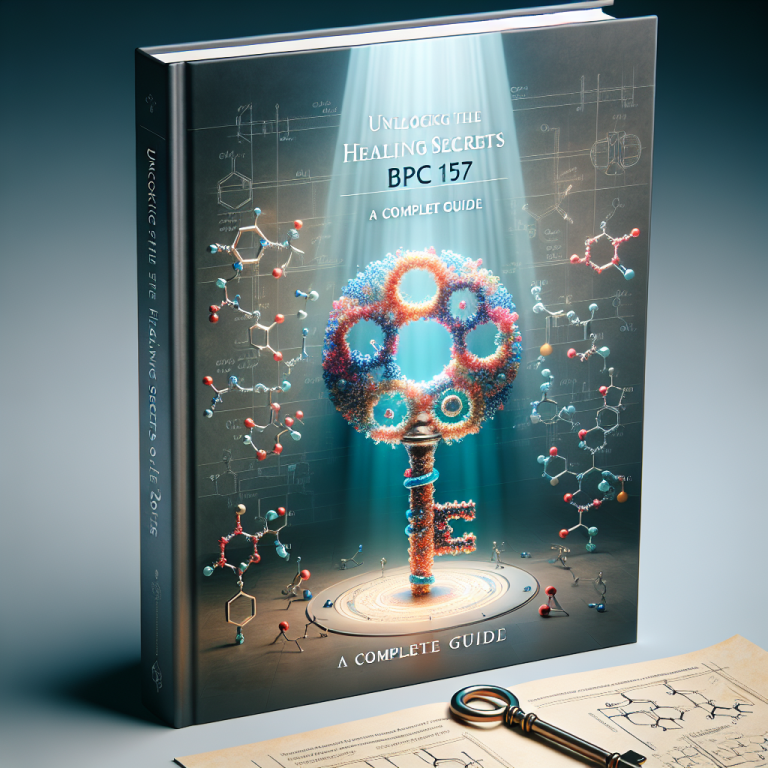Understanding BPC 157: Its Mechanisms and Effects on Healing
BPC 157, a peptide composed of 15 amino acids, has been gaining attention in the scientific community for its potential healing properties. This peptide, derived from a protein found in stomach secretions, appears to have a broad range of implications in healing various types of tissues, including muscle, tendon, and damaged ligaments. The mechanisms through which BPC 157 operates are complex and multifaceted, involving the modulation of various biological processes.
One of the fundamental aspects of BPC 157’s mechanism is its impact on angiogenesis, the process through which new blood vessels form from pre-existing vessels. This is crucial for healing as it ensures an adequate blood supply, which is essential for delivering nutrients and oxygen to damaged tissues, thus accelerating the repair process. Research has shown that BPC 157 promotes the expression of genes involved in the regulation and formation of endothelial cells, which are the building blocks of blood vessels. This peptide not only enhances the rate at which these cells are produced but also improves their survival and organization into new blood vessels.
Further extending its healing capabilities, BPC 157 has been observed to have anti-inflammatory properties. Inflammation is a natural response of the body to injury and infection, but excessive inflammation can lead to further cellular damage and delay the healing process. BPC 157 works by modulating the production of inflammatory mediators such as cytokines and by influencing the activity of nitric oxide (NO) systems. By reducing the levels of pro-inflammatory cytokines and regulating the functions of NO, BPC 157 helps in mitigating excessive inflammation and promotes a conducive environment for recovery and regeneration.
Moreover, BPC 157 influences the body’s production of several growth factors, particularly those related to the healing of bones and ligaments. For instance, it affects the expression of growth hormone receptors, thereby facilitating the processes that lead to bone and ligament healing. This is particularly significant in orthopedic and sports medicine, where joint and bone injuries are prevalent.
The gastroprotective properties of BPC 157 also deserve mention. Given its origin from a protein found in gastric juice, it is not surprising that BPC 157 can help in protecting and healing the gastrointestinal tract. This includes reducing inflammation in the gut, healing ulcers, and even protecting liver cells from toxin-induced damage. These properties make BPC 157 a compound of interest not only for those looking at musculoskeletal healing but also for addressing complex conditions like inflammatory bowel disease (IBD).
Despite its promising therapeutic potential, it is crucial to note that most of the current understanding of BPC 157’s effects comes from animal studies. The translation of these findings into human medicine is ongoing, with clinical trials being necessary to fully understand its efficacy and safety in humans. Researchers are particularly cautious and optimistic about the therapeutic windows that BPC 157 could open, potentially offering new avenues for treating a range of conditions that currently have limited solutions.
In conclusion, BPC 157 exhibits a remarkable array of healing properties, from enhancing angiogenesis and reducing inflammation to protecting gut health and influencing bone and ligament repair. As research progresses, it holds the promise of becoming a significant tool in the arsenal of regenerative medicine, potentially leading to groundbreaking treatments for various ailments. The continued exploration of this peptide will undoubtedly unlock further insights into its mechanisms and broader applications in health and disease management.
The Role of BPC 157 in Sports Medicine and Injury Recovery

BPC 157, a peptide composed of 15 amino acids, is becoming increasingly recognized in the field of sports medicine for its remarkable potential in accelerating injury recovery. Originating from a protein found in the stomach, BPC 157 has shown considerable promise in various studies for its healing properties, particularly in soft tissue repair. This has profound implications for athletes and individuals engaged in physical activities where injuries like muscle strains, ligament sprains, and tendonitis are common.
One of the pivotal roles of BPC 157 in sports medicine is its ability to enhance the healing process of tendons and ligaments. These tissues are crucial for the mobility and stability of joints but have poor innate healing capabilities due to low blood supply. Research suggests that BPC 157 promotes tendon and ligament fibroblasts proliferation, a type of cell responsible for the synthesis of extracellular matrix, which is vital for tissue repair. By augmenting these cells' activity, BPC 157 not only speeds up recovery time but potentially improves the overall quality of the repair, thus reducing the risk of re-injury.
Moreover, BPC 157's benefits extend to muscle healing, where it has been observed to counteract the effects of muscle wasting and damage. This is particularly significant in sports where muscle injuries are prevalent, affecting not just performance but also an athlete’s career longevity. The peptide facilitates muscle regeneration by stimulating the formation of new blood cells in the injured area, enhancing nutrient-rich blood flow which is essential for repair processes. This capability to improve healing mechanisms at a cellular level allows athletes to return to training and competition more quickly.
Additionally, BPC 157 has demonstrated anti-inflammatory properties, which are crucial in managing pain and swelling, typical symptoms associated with sports injuries. By modulating the inflammatory cascade, BPC 157 helps in reducing the severity of inflammation and shortens the recovery phase. This not only aids athletes in maintaining a more consistent training schedule but also minimizes the use of non-steroidal anti-inflammatory drugs (NSAIDs), which can have adverse effects with long-term use.
The application of BPC 157 in injury recovery is also noteworthy for its systemic effects. Unlike many treatments that have localized effects, studies indicate that BPC 157 may have a body-wide range of action. This could potentially lead to improved healing of multiple injuries simultaneously, a significant advantage for athletes dealing with multiple stress-related injuries.
Despite its promising benefits, the use of BPC 157 in sports medicine must be approached with caution. As with any emerging therapy, the importance of conducting comprehensive clinical trials cannot be overstated. Current research is primarily based on animal models, and human studies are necessary to fully understand the efficacy and safety of BPC 157 in clinical settings. Furthermore, the ethical implications and regulatory considerations surrounding its use need to be clearly addressed, especially concerning doping regulations in professional sports.
In conclusion, BPC 157 holds considerable potential in transforming approaches to injury recovery in sports medicine. Its abilities to accelerate healing, reduce pain and inflammation, and possibly offer systemic benefits underscore its significance. Moving forward, rigorous clinical research and clear regulatory guidelines will be pivotal in integrating BPC 157 into mainstream sports medicine practices, ensuring athletes can safely and effectively benefit from this promising therapeutic peptide.
BPC 157: Dosage Guidelines and Potential Side Effects
BPC 157, a synthetic peptide consisting of 15 amino acids, has garnered significant attention in the scientific community due to its potential healing properties. This peptide is a partial sequence of body protection compound (BPC) that can be found naturally in gastric juices. While not approved for clinical use in humans by any major regulatory bodies, ongoing studies aim to explore its therapeutic benefits for various conditions, including tissue repair and protection against damage. As research progresses, understanding the appropriate dosage and potential side effects of BPC 157 is crucial for ensuring its safe and effective use.
The dosage of BPC 157 can vary significantly depending on the specific needs and health conditions of the individual. Preliminary findings suggest that the peptide is effective at very low doses. Based on animal studies, a common dosage range might be anywhere from 1 to 10 micrograms per kilogram of body weight. However, translating these dosages directly from animal models to humans is not straightforward and requires careful consideration and adjustment by medical professionals. The administration of BPC 157 is typically done through injections, either subcutaneously or intramuscularly, which allows for direct absorption into the bloodstream. Some researchers are also exploring oral and topical forms of the peptide, which could potentially expand its applications and accessibility.
Transitioning from dosage considerations, it is equally important to discuss the potential side effects associated with BPC 157. Despite its promising benefits, the safety profile of BPC 157 is not yet fully understood, mainly due to the limited number of human studies. In animal studies, BPC 157 has shown minimal toxicity and no adverse effects at various doses. However, the absence of comprehensive human clinical trials means that potential long-term side effects remain unknown. Some anecdotal reports from individuals using the peptide suggest that side effects could include mild gastrointestinal discomfort and possible feelings of fatigue. Nonetheless, these reports are not substantiated by rigorous scientific studies, and therefore, should be approached with caution.
Moreover, as with any experimental treatment, there is the potential for unexpected interactions with other medications or underlying health conditions. This underscores the importance of consulting with a healthcare provider before starting any new treatment regimen, including BPC 157. A healthcare provider can offer guidance based on the most current research and tailor the treatment to the individual's specific health profile.
In conclusion, while BPC 157 presents a promising avenue for various therapeutic applications, its use must be approached carefully. The appropriate dosage and administration method depends heavily on individual factors that need to be evaluated by professionals. Additionally, the potential side effects, although seemingly minimal based on animal studies, require further investigation through rigorous clinical trials in humans. As the scientific community continues to explore the capabilities and limitations of BPC 157, potential users must remain informed and cautious, prioritizing safety and efficacy based on the latest available data.

